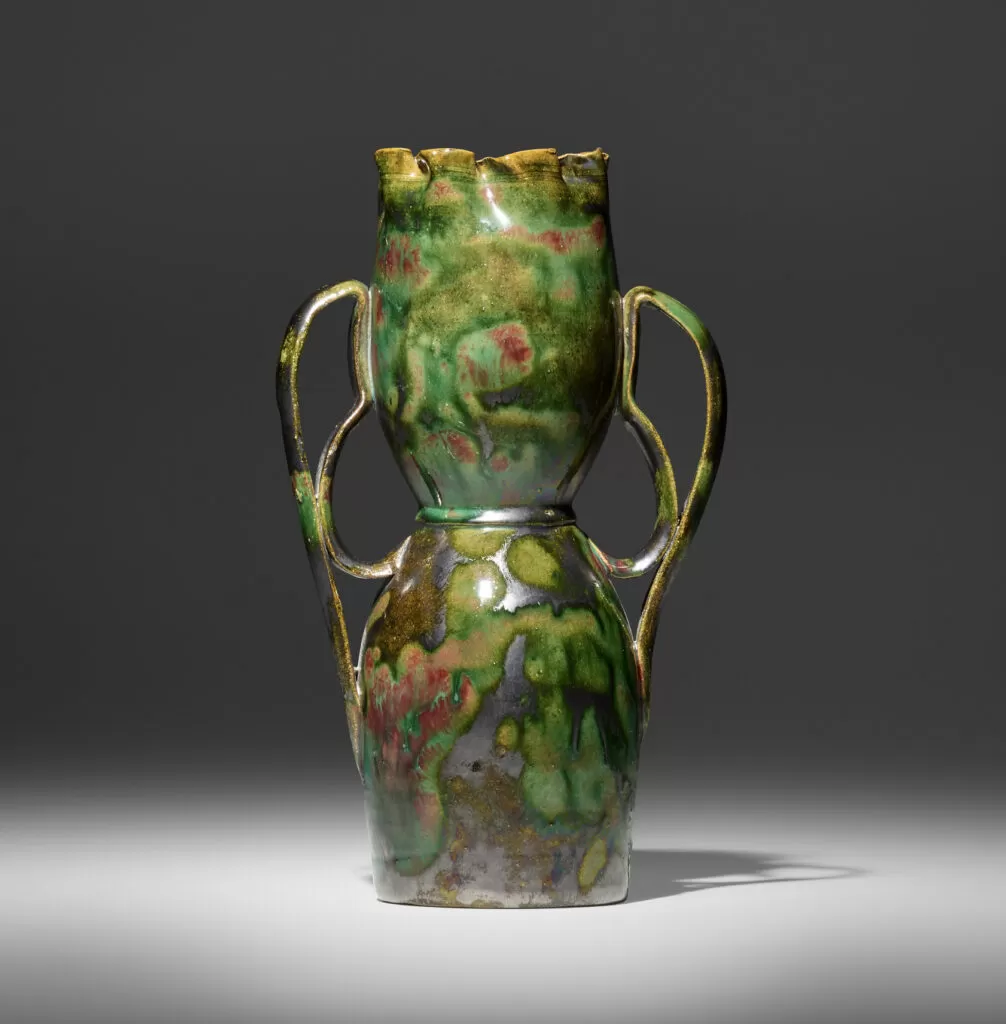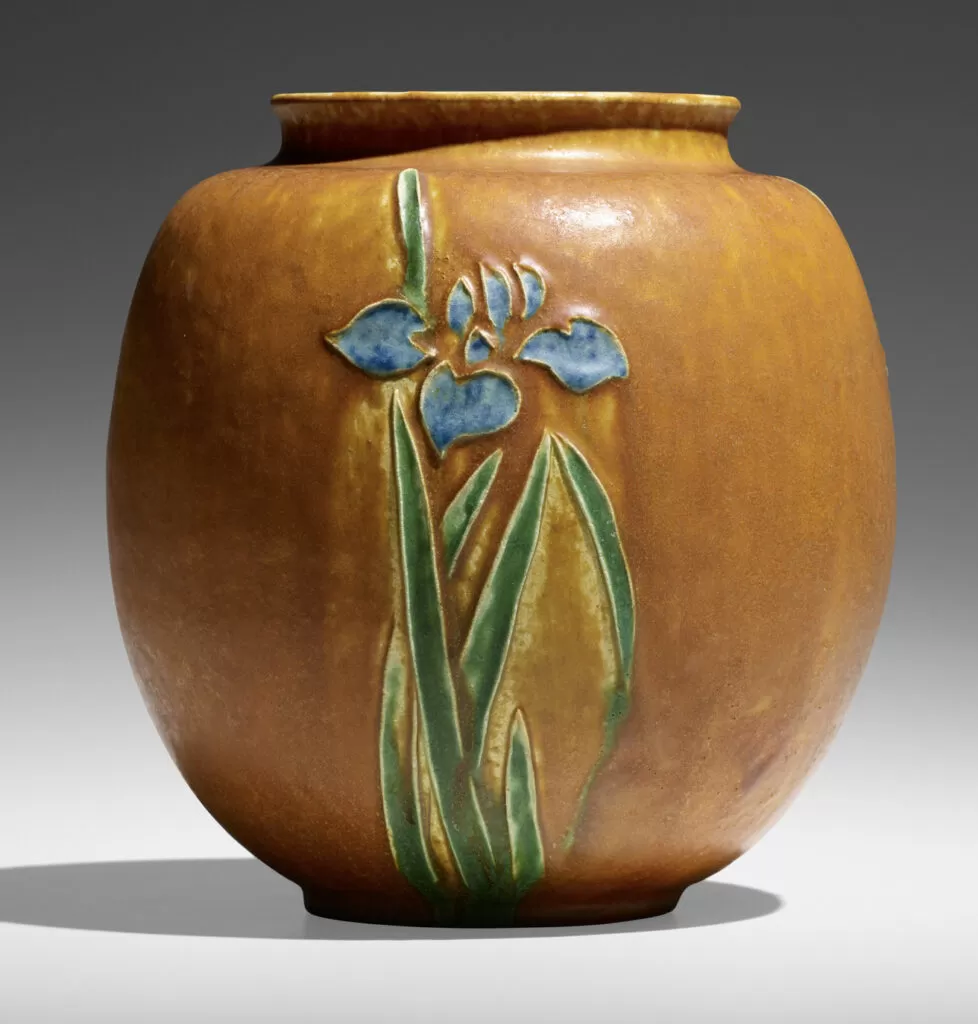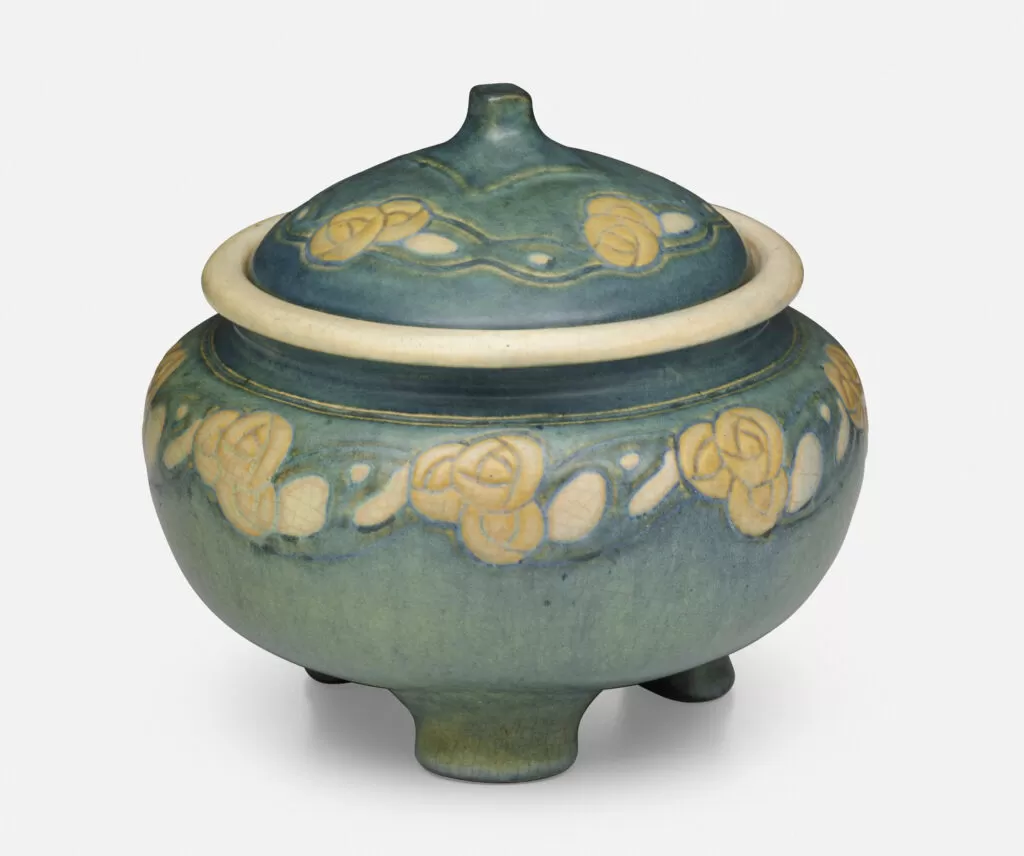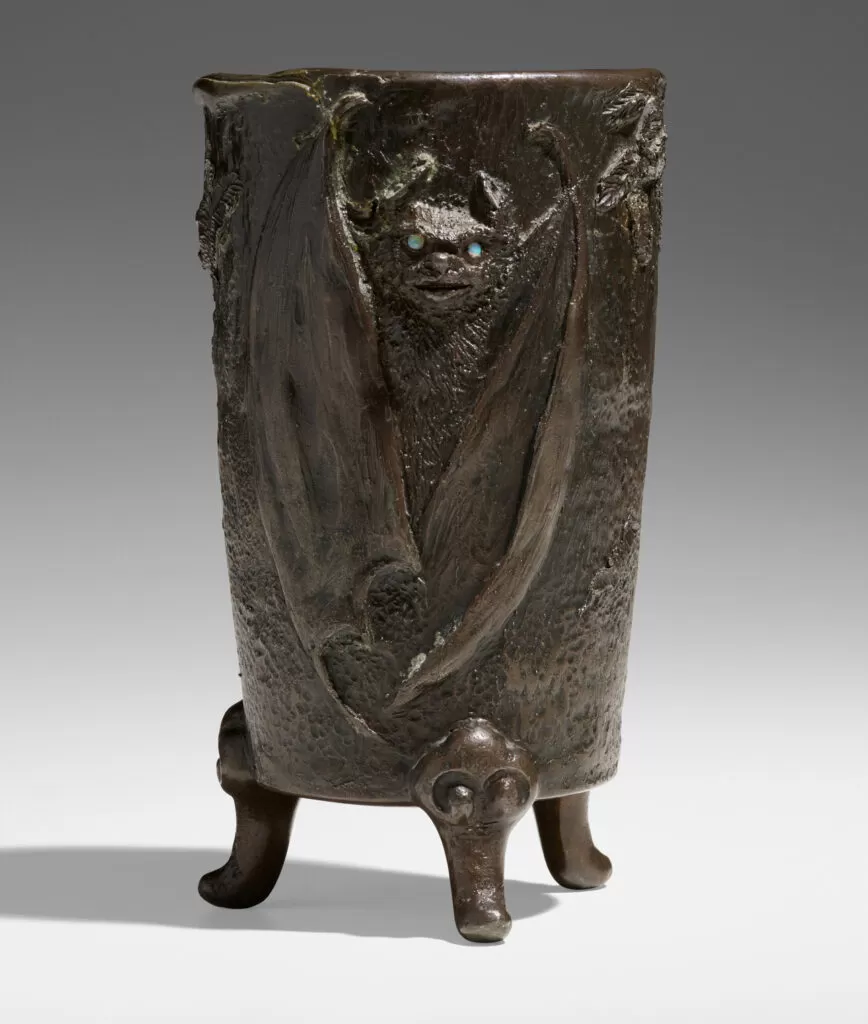Rie, Marshall and Hurley: A Review at Treadway PLUS Early 20th Century at Rago Thursday the 11th
by Kate Nixon
Last month’s Decorative Arts Auction from Cincinnati’s Treadway auction house brought another boost of excitement to the Arts and Crafts collecting world as its offerings of art pottery, lighting, fine art and other fields had collectors bidding online. A number of ceramic works and one particular copper box with an intricate and colorful enamel top stole the spotlight in this particular auction, but first, a few words about artists you may or may not know about…
Lucie Rie (1902-1995)
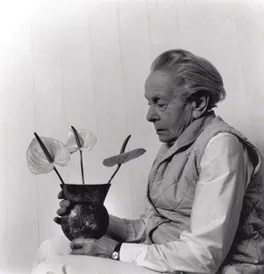
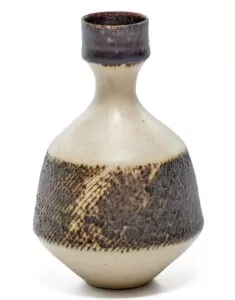
Lucie Rie was born in Austria in the Early 20th century and in her later years, would become essential to transforming the studio pottery movement in England and was inspired by the works of Josef Hoffmann. In 1938, having fled Austria for the United Kingdom due to rising Nazi influence, Rie’s works were influenced by the Arts and Crafts movement and Hoffmann in particular with its geometric designs and vertical orientation. As one who would experiment with new glazes, including raw glazing, Rie grew her reputation and her works were included in shows and exhibitions as Hoffmann chose her works in the 1937 Paris International Exhibition and nearly fifty years later, she was honored at the Victoria and Albert Museum in London with an exhibition on her work. In 1991, she was bestowed an additional english honor: damehood by the Queen of England. Thanks to David Rago for the information on Ragoarts.com.
The picture on the right is a Lucie Rie vase offered up at Treadway’s last month. The glazed ceramic vase with a stamped mark, measuring 5″h x 3.5″dia, with an estimate of $700 – $900, ended up selling for $2,400.
Frank J. Marshall

A small copper box with an enameled top from Frank J. Marshall was offered at Treadway’s Decorative Arts Auction.
Known for his works in the Boston Society of Arts and Crafts, the talents of Frank J. Marshall helped to bring back a lost art of enameling to America. Favorite designs of Marshall included landscapes, sailing ships, stylized flowers and depicting peacocks as well as decor of Japanese influence. His reputation grew outside Boston to include Chicago and New York. His work is most recognized in melding the worlds of metal with enameled art in both circular and rectangular boxes, lidded vessels, lamps, jewelry, and matchboxes.
The picture to the right is of a small copper box from Marshall, measuring 4.5″h x 4.5″w with an uncommon geometric design. was offered at Treadway with an estimate of $5,500 – $7,500. The enameled box sold for $11,000.
Edward Timothy (E.T.) Hurley (1869-1950)
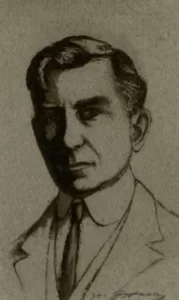
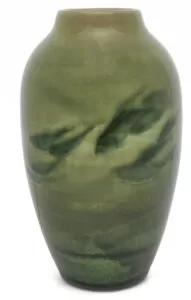
Several artists were employed by Rookwood Pottery since its origin back in 1880, but few artists can match the multi-talents of Edward Timothy Hurley: a true asset to the Rookwood name. His name is not only stamped on ceramics for his work as a designer for Rookwood, but his etchings and illustrations and even select metalworks still are found in auctions. E.T. Hurley is most known for his vellum glazed landscape plaques during his time at Rookwood, but the Cincinnati native was also a member of Hurley was a member of the Cincinnati Society of Etchers, Ohio Print Makers, the Duveneck Society, and a number of other crafters organizations and societies. At the St. Louis’s World’s Fair in 1904, Hurley was given a gold medal for his designing abilities.
The sea-green glazed ceramic vase made in 1902 offered at Treadway was artist signed, numbered, dated. Measuring 8″h x 4.5″dia with an estimate of $1,000 – $1,500, the Hurley designed vase sold for $3,000.
As usual, art pottery and ceramic works do very well at Treadway — Cincinnati is after all an art pottery capital and so essential to the history of the Arts and Crafts movement. The works of Newcomb College, Marblehead, Teco Pottery, Grueby, Fulper all sold either within their estimate or above. The rare Overbeck vase by Hannah Overbeck ($5,500-$7,500) sold for a respectable $6,000. The works of Tiffany Studios and Louis Comfort Tiffany are always a no-brainer although the rare decoration of a peacock feather on one Favrile glass vase ($500-$700) earned a final hammer price of $1,800. The many works of Weller pottery all sold within the estimates or above.
Art works includes several Gustav Klimt collotypes, two unusual colored etchings from E.T. Hurley, and a framed watercolor artwork attributed to Sir Edward Coley Burne-Jones (1833-1898). Lighting tended to sell well, including the works of Handel (one lamp with a tree trunk base and painted glass with intricate metal overlay decorative motifs ($3,000-$4,000) for the shade sold for $3,500) and of course the spotlighted item Tiffany Studios hanging “Clematis” lamp sold for a whopping $65,000.
Click here to see the realized prices for all lots in last month’s Decorative Arts Auction.
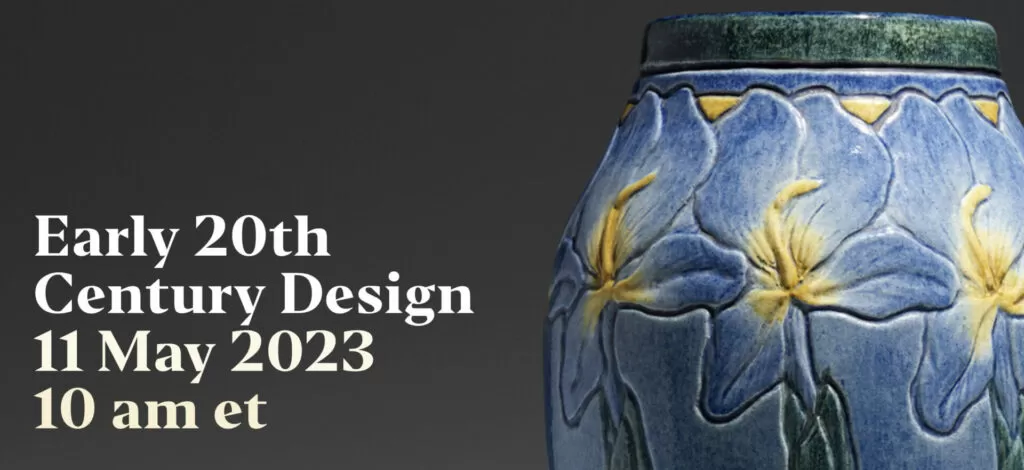
Early 20th Century Design
11 May 2023
10 am EST
Ragoarts.com
This Thursday’s Early 20th Century Design, starting at 10:00 AM Eastern, offers a top-tier selection of works by celebrated American and European makers of the 19th and early 20th centuries. Spanning furniture, lighting, ceramics, and decorative arts, this session’s highlights include ceramics by George Ohr, Newcomb College, Grueby, and Ernest Bussière, glass and lighting by Tiffany Studios, Daum, and Ernest Baptiste Léveillé, and rare works by Maria Longworth Nichols Storer and more.
Expect the fine and rare works of George Ohr to be shown and about including a few exceptional examples out of the 23 Ohr vases up for bid: one two-tiered model with mottled glaze in gunmetal over green, carmine and ochre ($35,000–40,000), and one with a a raspberry, gunmetal, green, and grey volcanic glaze ($25,000–35,000). One pitcher catches the eye simply because of the names attached: George Ohr and Susan Frackelton. From a private collection in Nebraska, this bisque earthenware pitcher ($2,000–$3,000) is one of a number of Ohr’s bisque earthenware works. A collection of 19 Fulper pottery vases are also up for bid, a number of them rare including a rare cattail vase ($4,000–6,000), a Leopard Skin Crystalline to Mahogany flambé-glazed stoneware vase ($1,500–2,000), a similarly glazed Early and Rare six-handled incense burner ($2,500–3,500) and an early unique pink Fulper vase on a stand ($2,000-$3,000). A lighting rare Vasekraft table lamp ($6,500–9,500) is an impressive lighting addition.
A variety of Grueby Faience ceramics will also be offered with rare and exceptional examples among them: a Rare and Exceptional vase with calla lilies ($15,000–20,000) has already gotten attention from online bidders (seven bids already), a rare and exceptional vase with Irises ($10,000–15,000) with its extremely rare multicoloring, a couple of rare green “Jungle Book” tiles (one tile has the estimates of $6,500-$9,000 and the other has $8,000-$12,000), and a number of other rare examples with that familiar Grueby green color. The thirteen examples of Newcomb College pottery are mostly rare, early, and transitional: the one pictured in the above header is an early and tall vase ($19,000–24,000) while there is also a selection of smaller vases with similarly lovely designs. Take the Ora Reams-designed covered jar, small in stature but with a trail of Mackintosh roses ($2,000–3,000) it is a very sweet addition to a massively impressive and expensive lineup. The Newcomb College vases with a full moon and spanish moss adorning the oak trees are additionally offered as are works by Henrietta Bailey and Anna Frances Simpson, two names popular with Newcomb pottery collectors.
Perhaps a more surprising find was the “Cat and Bat” vase ($6,500–9,500) designed by Maria Longworth Nichols Storer, a rare metal piece and with such a distinctive design – almost as if it came out of a early 20th century nightmare. The rare vase, silver electroplated on tin with semiprecious stones added in, is featured in “Breaking the Mold: The Metalwork of Maria Longworth Storer” is considered one of her “bronzes” which is really tin which Storer would patinate to imitate bronze. Where traditional bronze has to be handled in a foundry, tin can be melted at a low temperature in a kitchen or studio. With examples from the Saturday Evening Girls Club, Marblehead, Tiffany Favrile, Adelaide Robineau, Overbeck, Van Briggle, Teco Pottery, North Dakota School of Mines, Pewabic, Arequipa Pottery, and other examples, we’ll be watching at 10:00 AM to see which pots take the glory.
Several impressive and beautiful Tiffany lighting examples round out the Arts and Crafts offerings.
To see the complete Catalog of the Early 20th Century auction offerings, click here.

